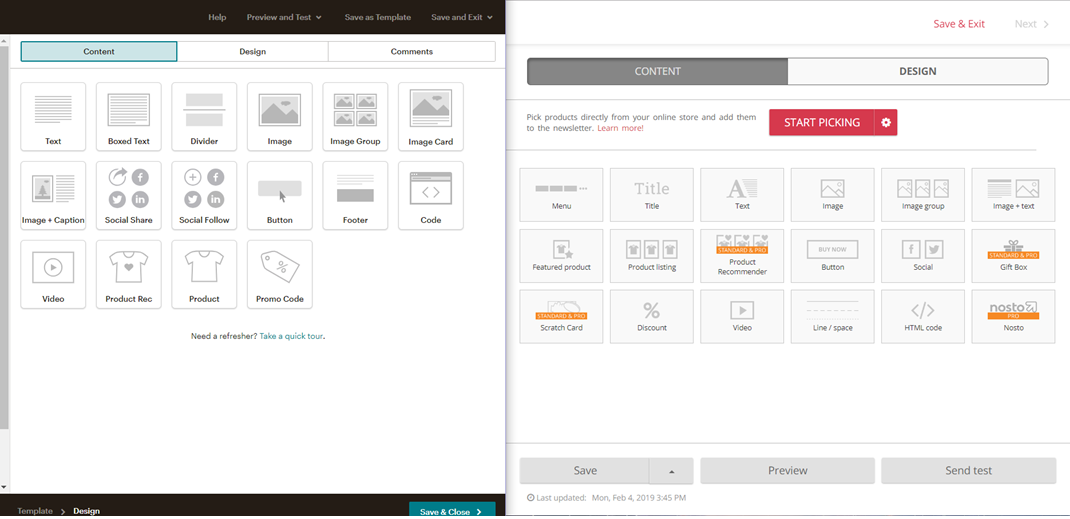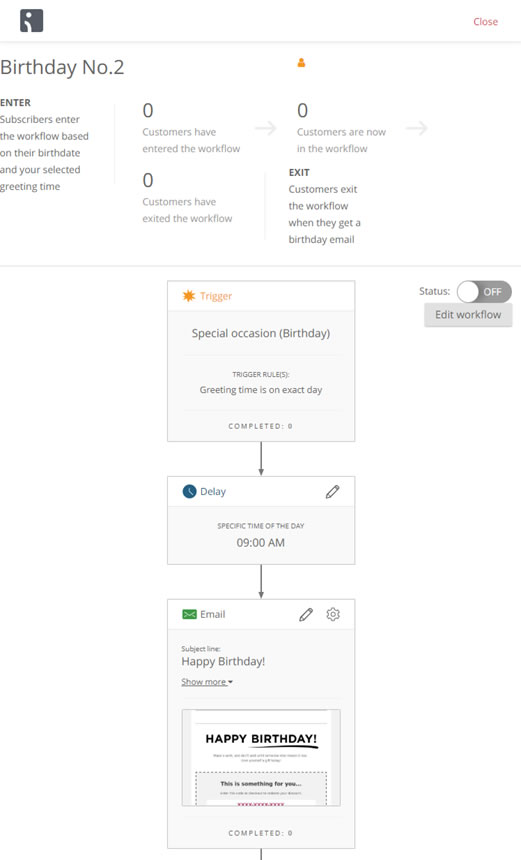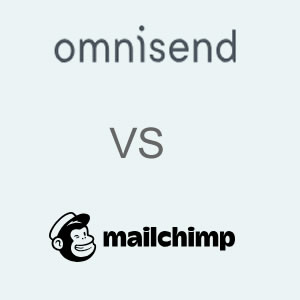When it’s time to choose a great email marketing automation provider, there are thousands of options out there. And there are quite a few alternatives to choose from, so doing good research on Mailchimp alternatives prices and features is the first logical step to make.
However, if there’s one tool that tops the list of most Mailchimp alternatives in 2019, it’s Omnisend.
The fact is, Omnisend and Mailchimp are very similar tools at face value. However, when I dig a little deeper, there are a few key differences that might seem small, but might ultimately be critical for your online store.
So I’m going to dive into the different features for these two tools and measure them up pound for pound.
1. Who is the Tool Built For?
While there is some overlap between the target audiences for both Mailchimp and Omnisend, there are clear differences as to where each tool is angled.
Mailchimp is geared towards small businesses and has a much broader audience than Omnisend. Omnisend, however, is crafted specifically around ecommerce.
While Mailchimp might be well suited for a variety of businesses, Omnisend’s focus on ecommerce means that it has features that are adapted for those unique needs of an online merchant and ecommerce marketer.
2. Integrations
If there’s one area where Mailchimp shines, it’s in their third party integrations. Mailchimp integrates with hundreds of different applications and web services allowing you to do a variety of things that otherwise wouldn’t be possible with Mailchimp alone.
Omnisend’s integrations are perhaps not as vast as Mailchimp’s, but the integrations they do offer are quite deep. Since Omnisend focuses on ecommerce marketing automation, they offer deep integrations with all major ecommerce platforms.
They also offer integration via API for custom integrations and Zapier connection for easy contact importation.
Depending on what you need email marketing for, you can opt for a ton of integrations or a few high quality ones. Regardless, when it comes to integrations, the likely winner here is Mailchimp.
3. Email Marketing
Each tool began as a purely email marketing tool. Each tool then moved to email automation, evolving from simple newsletters to more sophisticated email operations. From there, both tools began integrating new channels into the mix.
But when the dust settles, which tool ultimately does email marketing better?
It’s important to note that both Mailchimp and Omnisend have very very similar email building interfaces.

As we can see from Mailchimp’s side-by-side comparison with Omnisend, there are very many of the same features.
When it comes to building an email, their builders have subtle but key differences.
| Feature | Mailchimp | Omnisend |
| What You See is What You Get Editor (WYSIWYG) | ✔ | ✔ |
| HTML | ✔ | ✔ |
| Product Picker | ✔ | ✔ |
| Product Recommendation | ✔ | ✔ |
| Gamified Elements | ✖ | ✔ |
| Mobile Preview | ✔ | ✔ |
| 100% Customizable | ✖ | ✔ |
While Mailchimp and Omnisend have near identical drag-and-drop email builders, Omnisend has a few small features that Mailchimp doesn’t.
For example, one of the biggest things that I appreciated from Omnisend’s email builder was the ability to go in and edit the HTML of drag-and-drop blocks. This isn’t something you can really do with Mailchimp, though both tools allow you to add custom HTML as a block.
Also, Omnisend allows you to create a few gamified aspects to your email, for example a dynamic Gift Box or Scratch Card that gives your customer a discount or another prize of your choosing. While this isn’t something you can’t live without, it’s a rather nice touch.
When it comes to the physical email builder, Omnisend and Mailchimp are pretty much even.
Recommended: 10 Reasons Your Email Marketing is Failing (And How to Fix It)
4. Automation & Segmentation
Both Omnisend and Mailchimp are positioned on the automation aspect of email marketing. So let’s take a look and see which one does it better.
– > Automation Workflows
Omnisend starts off with 15 automation workflow templates you can choose from based on what you’re most interested in, like subscribers, shoppers, buyers, repeat buyers, and then the opportunity to create a custom workflow from scratch.
Mailchimp starts off with the same amount of templates based on whether you want to focus on tags, subscriber activity, ecommerce, date based, etc.

What’s especially irritating about this automation workflow is that you have to click on a separate link to edit each individual aspect of the trigger, email, etc, instead of editing all the elements from the same window.
Contrast with Omnisend, where you simply click on “edit workflow” and you can edit each step of the workflow from the same menu is much fewer clicks and less time.

What I also tend to prefer from Omnisend’s automation workflow is that you can set up who you want it sent to, and you’ll see exactly how many of your subscribers fall into that segment.
Omnisend tends to shine when it comes to having an automation workflow interface that’s intuitive. Mailchimp tends to really fail in this regard.
While Mailchimp allows you to customize each of the templates, the biggest difference between these two tools is that Omnisend allows you to integrate different channels into your automation workflows, whereas Mailchimp’s automation feels rudimentary.
For example, in Omnisend you can create a workflow starting with an email campaign and then follow it up with an SMS or a web push notification. This allows you to diversify your campaign experiences for your customers, while in Mailchimp, this is only possible with email.
If you can figure out Mailchimp’s automation interface, it should work alright, but Omnisend clearly wins this round for its simple to use workflow system.
– > Subscriber Segmentation
Segmentation in Omnisend and Mailchimp seems pretty similar- though at first it might seem like Mailchimp has more segmentation options as they’re not as categorized.
Both marketing automation tools allow for the same categories of segmentation, though it’s important to note that in order to use a segment in Omnisend, that segment needs to be created prior to adding it to the automation.
5. List Building & Email Capture
Both Mailchimp and Omnisend offer list building and email capture features to help you not only build a great email list, but keep all of the data in one centralized location.
Both tools use pop up forms and landing pages for lead and email capture, however there are a few differences between the two.
While Mailchimp’s interface is slightly easier to use for popup creation, it’s also limited. For example, you can’t target and segment your popups to only be shown to certain users.
Omnisend’s popup forms can be precisely targeted based on the segments you create and before you even begin to customize, you have pre-filled text to allow you to create your popups even quicker.
But that’s not where Omnisend really beats Mailchimp on landing pages and email list building. Omnisend offers gamified popups like the Wheel of Fortune, where users have to enter their email address to spin for discounts or prizes you customize.
While it’s often said that an exit intent popup is much more dynamic than many other kinds of signup forms, a gamified form is sure to be the most interesting for your customers.
For this reason, Omnisend wins out over Mailchimp when it comes to email list building.
6. Pricing & Support
The next battlefield between these two great email marketing automation tools is on pricing and support. After all, a tool can be the most amazing email marketing suite on the market, but if you can’t afford it or if you can’t get support when things go wrong, none of it matters.
– > Pricing
Both Mailchimp and Omnisend scale their pricing models based on how many subscribers you have.
However, Omnisend’s pricing scales a lot more linearly than Mailchimp’s does. When I used Mailchimp, I had a hard time figuring out how much I was going to be paying per month without using their on-site calculator.
Mailchimps pricing goes as follows:
- Free forever plan up to 2000 subscribers and 12,000 emails per month
- Grow plan starts at $10 for 500 subscribers, with $5 added for each 500 subscribers you add.
- Pro plan starts at $199 per month plus
- $10 for 0-500 subscribers
- $15 for 501-1000 subscribers
- $20 for 1001-1500 subscribers
- And so on
The Pro plan basically functions as $199 plus the cost of what you would pay on the Grow plan. Mailchimp certainly scales a bit easier than a lot of email marketing tools, however, it also wins the award for the most confusing pricing on the market.
Omnisend’s pricing is a lot more straightforward. Like every other tool on the market, it does increase as you increase your number of subscribers.
Omnisend’s pricing goes as follows:
- Free forever plan up to 15,000 emails per month, or 2000 emails per day, with no subscriber limit
- Standard plan starts at $10 per month up to 500 subscribers, and increases by $5 per every 500 subscribers you add
- Pro plan starts at $199 per month and only increases starting from 9001 subscribers, where it increases to $210 per month.
So which tool gives you more bang for your buck?
Let’s compare based on subscriber counts in each plan:
| Subscriber Count | Mailchimp Grow | Omnisend Standard | Mailchimp Pro | Omnisend Pro |
| 1000 | $15/month | $15/month | $214/month | $199/month |
| 5000 | $50/month | $50/month | $249/month | $199/month |
| 10000 | $75/month | $85/month | $274/month | $210/month |
| 15000 | $150/month | $150/month | $349/month | $380/month |
The answer? It ultimately depends on how many subscribers you have, and what plans you want.
– > Support
In Mailchimp, email and chat support is available for those who pay for a plan. For their free users, email chat is available to help get new users set up in their first 30 days.
While this is a pretty significant issue for a lot of the people who use Mailchimp, there is an extensive knowledge base and plenty of community support forums to help.
For pro users, they do offer premium support too.
In Omnisend, 24/7 email, chat, and Facebook support is available to anyone, regardless of whether or not they pay for the service, or if they’re even a customer. This is one of the ways that Omnisend really stands out in email marketing automation tools.
Conclusion:
Both tools are fierce competitors, with one as an industry leader for small businesses, and the other a rising star for ecommerce companies.
Going back over the different aspects of these reviews, our major takeaways are:
- Omnisend and Mailchimp are neck and neck when it comes to email and newsletter creation
- Mailchimp wins in quantity of integrations and apps, however Omnisend has deeper integration with ecommerce platforms
- Segmentation and automation function better in Omnisend with integration of channels into automation workflows
If you are using any of these two tools, let me know in the comment box below.

Comments are closed.